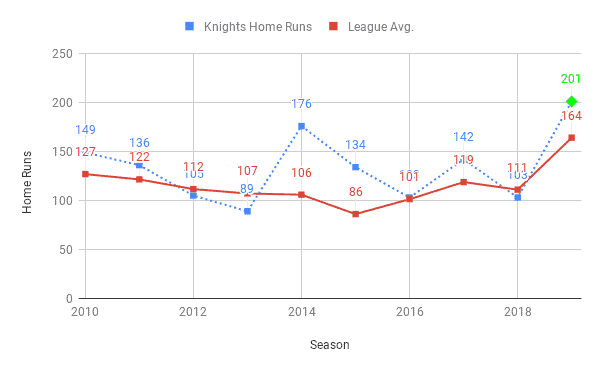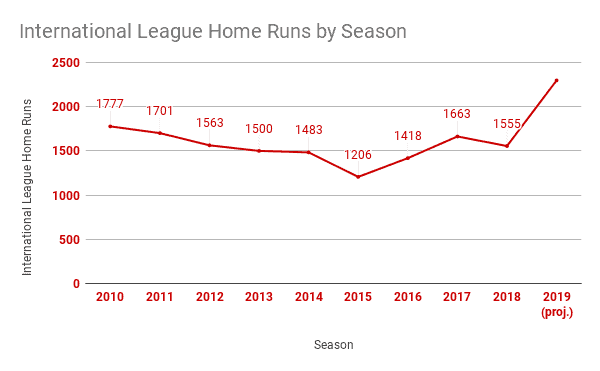The Charlotte Knights have scored 166 runs in 25 games after Monday’s game. That’s an average of 6.6 runs per game which leads the International League, and it's nearly a three-run improvement over last season’s average 3.8 runs per game. A surprising amount of offense generated that features a team of ex-major leaguers, a few AAAA-type players, and a top prospect in Zack Collins.
A significant source of this offense comes from a substantial increase in home runs. In 2018, the Knights as a team hit 103 home runs in 139 games played, or 0.74 home runs per game. A season later, and the Knights have hit 36 dingers in 25 games, or 1.4 homers per game. It’s a small sample size with just one month on the books, but to almost double their home run output is eye-opening. The Knights are projected to hit 201 home runs in 2019 with the league average to be 164.

It’s just not the Knights. All of the teams in the International League are launching more balls over the fence.

Since 2010, league home runs saw a steady decline from ‘10 to ‘15, and they had been on the rise for three straight seasons before last year’s dip. Minor League Baseball before the season announced they were changing the ball to be the same as they are in the majors. Some, like JJ Cooper of Baseball America, find the ball to be the source of a massive scoring increase in AAA.
Even if the Triple-A home run rate doesn’t increase with warmer weather, at the current rate Triple-A would see 1,200 additional home runs compared to last season. It would mean that the average Triple-A team would hit 158 home runs this season. Last year, Triple-A teams averaged 117 home runs and only three of the 30 teams hit 158 or more home runs. Right now, the average pitcher’s ERA in Triple-A baseball is 5.01. Last year it was 4.25.
The International League as of April 29, has hit 363 home runs in 156 games for an average of 2.3 homers per game. Using the number of games played in 2018, the International League is on pace to hit 2,297 home runs. An increase of 742 from last season.
Leading the way for Charlotte in the power department is Matt Skole and Zack Collins. Not a surprise considering power is their best attribute, but Skole already has seven home runs, and Collins has six. Both are on pace to hit more than 35 homers in AAA in 2019 if they play a full season without being called up.
While it’s expected for hitters like Skole and Collins to flex at the plate, where we might be seeing this new found slugging comes from players like Danny Mendick. Since being with the organization in 2015, the most home runs Mendick has hit in a season was last year in AA with 14. In 2019, Mendick already has four home runs and is on pace to hit 23 for the season. Not known as a power hitting middle infielder, Mendick has noticed a difference from last year playing with Birmingham.
“Yeah, there’s definitely a difference,” said Mendick. “It seems like the ball jumps off the bat a little more, but it’s still baseball. You have to square it up, and hit it well. Some of the parks we play in are really big, and the ball gives hitters a fair chance because all of these pitchers throw nasty pitches.”
Another player that’s posting an eye-raising slugging percentage is Charlie Tilson. In 42 games at the major league level, Tilson’s slugged .296, and it wasn’t much better in his time at the minor league level. Spanning 559 games, Tilson has a .384 slugging percentage that doesn’t scream power hitter.
In 2019, Tilson is slugging .518 with seven doubles, two triples, and a home run. His season-high mark was in 2014 when he slugged .414 so never in his career has Tilson produced this much power.
“I put in a lot of work in this offseason to make adjustments,” said Tilson. “On top of that, we have a great hitting coach here [Frank Menechino] that helped me put the puzzle pieces together.”
“In the past, I knew I had it in me to hit for power, and it left me last season. I knew I had it still in me; it was just a matter of getting my mechanics and timing right.”
Unlike Mendick, who fields his position in the dirt, Tilson has a unique perspective handling center field for the Knights where he is often chasing after juiced fly balls. While it does make his job harder defensively, Tilson finds the new balls are a good thing for the league.
“I think that was a good adjustment by the league to switch the balls. At the plate, you don’t really have to adjust because you’ll be more fortunate when you barrel up. Even for pitchers, I think it’s advantageous because the ball is wound tighter. They can make their adjustments here in AAA before trying to figure it out in the majors.”
While the ball deserves a fair share of the credit for a significant spike in the offense to start 2019, the players still have to execute. Maybe a less lively ball used in lower levels is masking power a prospect may genuinely have. Alternatively, these numbers early in AAA are possibly fool’s gold. Very shiny and hope the value is real but put it under a microscope, and more times than not it’s fake.
Even if the ball is juiced, Mendick is still giving all of the credit to what’s going on in the clubhouse for the Knights early success.
“We have a really good team. To be able to come out here and score a lot of runs is a high energy game. That’s what this team is all about; high energy.”





